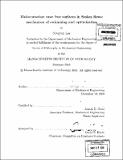| dc.contributor.advisor | Anette E. Hosoi. | en_US |
| dc.contributor.author | Lee, Sungyon | en_US |
| dc.contributor.other | Massachusetts Institute of Technology. Dept. of Mechanical Engineering. | en_US |
| dc.date.accessioned | 2010-08-30T14:42:48Z | |
| dc.date.available | 2010-08-30T14:42:48Z | |
| dc.date.copyright | 2010 | en_US |
| dc.date.issued | 2010 | en_US |
| dc.identifier.uri | http://hdl.handle.net/1721.1/57697 | |
| dc.description | Thesis (Ph. D.)--Massachusetts Institute of Technology, Dept. of Mechanical Engineering, 2010. | en_US |
| dc.description | Cataloged from PDF version of thesis. | en_US |
| dc.description | Includes bibliographical references (p. 105-[111]). | en_US |
| dc.description.abstract | Locomotion of biological systems have fascinated physicists and engineers alike for centuries. In particular, we are interested in the motion of self-propelling bodies near an air-water interface in the low Reynolds number limit. To investigate this problem, we take two very different approaches. We first consider the locomotion of a specific organism, namely, a water snail, that exhibits a striking ability to "crawl" beneath the free surface. By modeling the foot of the snail as undergoing a simple sinusoidal motion, we apply lubrication approximations for small deformations to rationalize this peculiar mode of transport and its dependency on surface tension. Inspired by this study, the second part of my thesis focuses on the general two-dimensional model of an organism that utilizes a free surface to propel itself. Based on conformal mapping techniques, we are able to derive exact solutions describing the highly nonlinear coupling between the motion of the swimmer and the free surface deformations, without putting any limits on the deformation size. These closed-form solutions are then applied to optimization questions. In the high Reynolds number limit, swimming near the free surface is known to increase drag on the swimmer due to the cost associated with creating surface waves. However, we find that, for a low Reynolds number swimmer that utilizes the free surface to move, a different power law relation between the distance from the interface and the swimming efficiency exists, implying that the presence of the free surface can be beneficial in certain parameter regimes. | en_US |
| dc.description.statementofresponsibility | by Sungyon Lee. | en_US |
| dc.format.extent | 105, [6] p. | en_US |
| dc.language.iso | eng | en_US |
| dc.publisher | Massachusetts Institute of Technology | en_US |
| dc.rights | M.I.T. theses are protected by
copyright. They may be viewed from this source for any purpose, but
reproduction or distribution in any format is prohibited without written
permission. See provided URL for inquiries about permission. | en_US |
| dc.rights.uri | http://dspace.mit.edu/handle/1721.1/7582 | en_US |
| dc.subject | Mechanical Engineering. | en_US |
| dc.title | Biolocomotion near free surfaces in Stokes flows : mechanism of swimming and optimization | en_US |
| dc.type | Thesis | en_US |
| dc.description.degree | Ph.D. | en_US |
| dc.contributor.department | Massachusetts Institute of Technology. Department of Mechanical Engineering | |
| dc.identifier.oclc | 648982083 | en_US |
